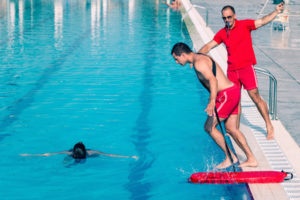 Water emergencies can happen at anytime. Even experienced swimmers are at risk in and around water, and those who are not strong swimmers are at an even greater risk. The keys to minimizing the chances of these emergencies are to remain alert at all times and to be able to recognize the situation before it is too late.
Water emergencies can happen at anytime. Even experienced swimmers are at risk in and around water, and those who are not strong swimmers are at an even greater risk. The keys to minimizing the chances of these emergencies are to remain alert at all times and to be able to recognize the situation before it is too late.
There are three stages of a water emergency: distressed swimmer, active drowning victim, and passive drowning victim.
Distressed Swimmers
Distressed swimmers are not drowning, but they are in trouble. There are many reasons a swimmer can require assistance, including exhaustion, sudden injury or illness, and changes in the water conditions.
A distressed swimmer is struggling in the water. While his or her head is above water and he is breathing, he is likely struggling to hold onto anything that is floating around him or he is visibly searching for help. He may or may not call for help or wave his arms, and he will be making little or no forward progress in the water.
Distressed swimmers who don’t receive help often become drowning victims.
Active Drowning Victims
Active drowning victims are struggling to breathe and stay above water. Because of this, he or she will exhibit the universal drowning response. It’s important to understand that drowning does not happen like it appears in the movies; it’s essential to be familiar with the reality: drowning happens quietly.
An active drowning victim is struggling to keep his or her mouth above water and will not be able to call out for help. She will be working to keep her body vertical with her head tilted upwards, but children may tip forward into a facedown horizontal position. Her arms will be at her sides or in front of her, pressing downward in an attempt to keep herself afloat. Her head will be at the surface of the water or dipping below the surface.
Passive Drowning Victims
Passive drowning victims are not struggling. Whether due to sudden illness or injury or as a result of drug or alcohol use, some drowning victims slip underwater without visible warning.
A passive drowning victim’s face or head will be submerged in the water, and he or she will not be breathing. He may be floating facedown at the surface of the water or fully submerged. If he is fully submerged and sinking to the bottom, he may simply look like a shadow.
Providing Assistance in a Water Emergency
In the event of an emergency, you must first assess the situation. If you decide the person needs help, immediately alert the lifeguard to the emergency, if one is present. If a lifeguard is not present, decide whether you can safely provide assistance. Do not enter the water if the conditions are above your skill level, and always call 9-1-1 for help in the event of an emergency.
Through first aid training, water safety classes, and swim lesson programs, Premier Aquatic Services is dedicated to providing our local community with the skills they need to be safer in and around the water. To learn more about our health and safety classes, please visit our website.
Enrollment in our fall swim programs has begun. Click here to explore our fall class schedule.